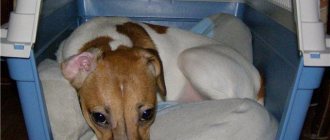What is motion sickness and why do animals suffer from it?
Motion sickness, kinetosis, seasickness is a feeling of nausea that occurs in moving vehicles. This condition is associated with the functioning of the vestibular apparatus and can occur not only on a ship, but also in a car, train, bus, or plane.
Seasickness in dogs is a common problem.
Causes of motion sickness:
- critical difference between visual information and signals coming from the vestibular apparatus to the central nervous system. The brain does not understand what position the body is in, which causes nausea and vomiting;
- The vestibular apparatus is located in the inner ear and is responsible for the position of the body in space. If its receptors are too active, an unpleasant sensation of motion sickness may occur.
This problem is extremely widespread. When traveling and traveling with your pet, it happens that the dog vomits in the car. Puppies under 1 year of age are especially affected. At this age, the body is actively growing, and the vestibular apparatus is only strengthening.
For your information! It’s the same with people: small children have a hard time with traveling due to seasickness, but with age, this goes away for many.
It is advisable to sit the puppy next to a window so that he looks outside, otherwise he may get motion sickness.
Your pet gets sick less if he looks out the window ajar
Why do dogs get carsick?
Kinetosis (motion sickness) is caused by structural features of the vestibular apparatus of dogs. It occurs most often in the first year of life, when the puppy’s apparatus has not yet fully formed. It is located in the inner ear and, at the slightest change in body position, transmits a signal to the brain. There, the received information is processed, then the brain sends commands throughout the body in order to restore balance.
Shaking while driving makes the signal flow chaotic. For example, the eyes can signal that the animal's body is in motion, while the paws remain in place. If the dog does not look out the window while moving, an imbalance occurs, since the brain knows that the body does not remain in place, but the vision does not observe this. This is how kinetosis occurs.
This is reminiscent of a situation when poison enters the body: the transmission of impulses to the brain is disrupted and is chaotic. To get rid of the poison, the body resorts to vomiting; a similar reaction occurs when motion sickness occurs.
Some medical factors related to the pet's health condition also lead to kinetosis:
- disturbances in the activity of the vestibular apparatus due to complications after otitis media, traumatic brain injury, acoustic neuritis, tumors, sulfur plugs;
- pregnancy;
- treatment with certain medications: antibiotics, sulfonamides, drugs for neurological pathologies.
According to the observations of dog handlers and veterinarians, about 75% of puppies up to one year old suffer from kinetosis. At older ages, their number decreases to 25%. However, susceptibility to motion sickness does not depend on the breed.
Large trained dogs that have good physical training and conditioning suffer the least when traveling in transport. Active movements strengthen the animal’s vestibular apparatus, developing stress resistance and endurance.
Symptoms of motion sickness in dogs
Based on a number of signs, the owner will be able to notice that the dog is feeling unwell. The main symptoms of seasickness:
- frequent shallow breathing;
- salivation;
- blue tongue;
- nervousness, anxiety;
- the dog sticks out its tongue or licks its lips and nose;
- the animal is looking for a comfortable position;
- nausea, vomiting.
A dog was bitten by a wasp in the paw or face: what to do?
It is easy to recognize if a pet is feeling unwell in a car. If your dog starts drooling or vomiting, it means he's getting motion sickness. All these symptoms indicate that your pet needs help.
Important! If your dog has a blue tongue, you need to take him to the vet as soon as possible, because this could be a sign of not only motion sickness, but also heart problems.
Animals need to be accustomed to driving from a very early age.
How to get rid of motion sickness in a dog in the car?
In order for the pet to feel good throughout the trip, and for the owner to enjoy the views outside the window and not get nervous next to the dog, you need to follow a few simple rules.
Try to avoid strong and unpleasant odors in the car - don’t smoke, leave various car interior fragrances at home, don’t use perfume. Remember that a dog’s sense of smell is very developed; even a slight aroma for a person can become an unbearable stench for a dog. Try not to feed the animal before going on the road, at least 1.5-2 hours. An empty stomach means a reduced likelihood of vomiting. Walk your dog thoroughly before he sets off. The absence of the urge to urinate and defecate is the key to calm and tranquility. Try not to disturb the silence with loud sounds - do not turn on the radio, at least until your pet gets used to it
If you are traveling in a noisy company, try to be quieter, because your family member is unwell - put yourself in the place of the animal. It is very important that the dog is close to its owner (only if he is not driving). Try to support your pet, stroke it, calm it with your voice and hugs. Be sure to leave one window slightly open when driving the car to allow fresh air to flow through the cabin.
However, make sure that the dog does not sit in an open draft, as it may get sick. A dog can be compared to a child - it is also afraid, does not understand much, and is at the mercy of adults. Therefore, the driver must understand that sharp turns, braking and acceleration should be avoided whenever possible. All this provokes even more motion sickness. The trip should be measured, calm and safe. If you see that your pet is feeling unwell, stop the car, give the dog the opportunity to get out, run around, and recover. The baby will probably want to drink some water or go to the toilet, especially if the trip is long. Be sure to take into the car what your pet loves - familiar toys, clothes with the owner’s scent, if he is not nearby. You can take some of your favorite treat, but remember that overeating causes nausea.
To get your dog used to traveling, you should regularly take it in a car, this way you train the vestibular system. Try to start with short journeys, gradually increasing the time and distance of the route. For the very first time, you don’t even have to go anywhere - just stay in the car, the dog should associate the situation with something pleasant.
If all this does not help, the baby has grown up, but has not learned to cope with motion sickness, you should consult a veterinarian. In some cases, there is nothing left to do but use special drugs
But for this it is important to figure out what your dog feels during the trip - is it fear or is it really kinetosis? Start with the simplest herbal sedatives. They will help your dog relax and experience the trip more at ease.
If anxiety is accompanied by excessive drooling and vomiting, more serious medications may be needed that affect the nervous system, suppress the vomiting reflex, or smooth the stomach muscles. You can take them only after consulting a doctor.
Motion sickness is a serious problem, both for the animal itself and for its owner. But, unfortunately, you cannot do without travel, so you need to look for a solution to this problem, and as soon as possible.
Tips before your trip
A dog was bitten by a bee: what to do at home
Many owners get confused and panic if their dog gets sick in the car; everyone needs to know what to do and how to help their pet. There are many effective ways to solve this problem.
What to do if your dog is vomiting in the car:
- To prevent seasickness, your pet needs to be accustomed to traveling from a very young age. At first, you can put the puppy in the car for a few minutes. Then the time spent traveling by car must be gradually increased. If the dog behaves well and sits calmly in the car, it should be rewarded with a treat;
- You should not feed the dog approximately 6–8 hours before departure. Instead of food, it is better to offer her water;
- just before the trip you need to take a longer walk with your pet;
- Be sure to take a bowl and a bottle of water with you so that the animal can drink on the way;
- during a long drive, you need to periodically stop for a short time so that the dog can take a walk and drink fresh water;
- be sure to open the window slightly so that the puppy can breathe fresh air and look outside;
You need to take treats and toys on the road
- pungent odors and loud sounds in the car interior unnerve the pet, and this aggravates its condition. It is advisable to refrain from smoking and listening to music;
- It is advisable to take your favorite dog toys with you so that you can distract your pet;
- You can transport your dog in a carrier or fasten it with a seat belt;
- If possible, you should choose a flat and smooth road without potholes or depressions;
- Many dog breeders are trying to find out what to give their dog for motion sickness in the car, what medications are available for this disease. Medications should be used only if nothing else helps the animal. When all methods have been exhausted, you need to contact your veterinarian for a prescription for seasickness medication.
Note! If the dog has already started vomiting, you need to hold its head and urgently lay out a bag or diaper. It is worth calming your pet and stopping the car if possible. A short walk and some clean, cool water will improve your pet's well-being.
Good to know
Before you start giving your pet tablets for motion sickness in transport, you should pay attention to several nuances.
Usually, small puppies suffer from kinetosis. This is due to the fact that at a young age their vestibular apparatus is not yet developed enough to tolerate such complex movements. These kids should not be carried in the car. It is better to wait a few months until the body gets stronger.
Also, a similar problem may arise if the four-legged dog’s first car ride was associated with a stressful situation. For example, if a puppy was taken to the veterinarian for vaccinations, he remembers this information and begins to worry a lot. This problem is psychological in nature, in this case it is not at all necessary to give your pet tablets for dogs against motion sickness.
The best thing to do is try to reprogram your puppy's memories. To do this, it is enough to take him by car several times for a walk outside the city, to the forest, to the river or any other place where he likes to relax and have fun.
Sweet candy as a remedy for motion sickness
What to feed your dog at home and how to do it correctly
A sweet treat, such as candy, will raise your blood sugar levels. This is very important for a hungry dog, because it is best to travel on an empty stomach, otherwise the pet will vomit.
For your information! There are many drugs known to help people with seasickness. One of the best is considered to be dimenhydrinate, which can be bought at a pharmacy without a prescription. Other trade names for this medicine are Daedalone, Dramamine, Novago, Ciel.
Owners are wondering if it is possible to give their dog Dramamine for motion sickness. This drug should be taken with great caution. Before any trip, you should consult with your veterinarian and purchase the motion sickness remedy for dogs that he recommends. When traveling by car, you should carefully monitor the condition of the animal.
It is advisable to place a diaper on the seat
In addition to Dramamine, there are many known tablets designed specifically for animals:
- graying. Take 1–2 hours before departure at a dosage of 8 mg per kilogram of dog weight. One tablet is effective for 12 hours. Not suitable for pregnant and lactating animals, as well as puppies under 4 months. At the veterinary clinic you can give an injection of this drug;
- racefit. This remedy can be given to the puppy within 30 minutes. before departure. It gives a powerful effect for 6 hours. The maximum daily dose is three tablets. Contraindications: epilepsy and weight less than 2.5 kg;
- relax sanal is a sedative that helps the animal relax and also relieves nausea. If your pet is terrified of traveling, you can give him these tablets 3–4 hours before travel, but no later than 1–2 hours before departure. The medicine protects against motion sickness for 6 hours. Relax Sanal Large was created for large dogs;
- veterinarian calm Calms, relieves spasms, reduces muscle tone and activity of the vestibular apparatus. Has a beneficial effect on the heart. This suspension should be given to the dog 2 hours before the trip. The dose is calculated as follows: 1 ml per 10 kg of body weight.
Note! Additionally, you can offer your pet sedatives: “Stop-stress”, “Cat Bayun”, “Fitex”. Veterinary medications are developed taking into account the characteristics of pets, and therefore will bring more benefits than human medications.
"Relax"
These motion sickness tablets for dogs are made with tryptophan. This component promotes the production of serotonin. It has a calming effect on the animal, and the pet does not feel sick.
For dogs whose weight is less than 5 kg, it is recommended to give 1-2 tablets approximately an hour before departure. If the pet weighs from 5 to 15 kg, then it is worth increasing the dosage to 2-4 tablets. If the animal weighs more than 15 kg, it will require more drug. In this case, you can feed the dog 5-6 tablets.
The price of motion sickness tablets for dogs can range from 100 to 1500 rubles. It all depends on the manufacturer and the active component. However, you shouldn’t skimp on your pet’s health. It is better to buy products from trusted manufacturers and be sure to consult a veterinarian first. He will tell you which medications are best for the animal.
Adjusting the air pressure inside the machine if the dog is vomiting
The car window must be lowered by 2-5 cm so that more oxygen enters the cabin. In addition, this will balance the air pressure inside the machine and outside. This proven method will help prevent the onset of motion sickness symptoms in both dogs and people.
In most cases, motion sickness goes away with age











